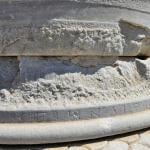
“The Washington Post” had a rather remarkable feature, in a special Museums insert, on this painting, the Alba Madonna by Raphael. Painted around 1508 and currently in D.C.’s National Gallery, it’s considered the high point of Renaissance art and one of the greatest paintings ever made. But why? The Post asked some art historians, and two of them zeroed in on Raphael’s portrayal of Christ.
From Leo Steinberg:
This is the action: The little Saint John is presenting the cross to the Christ child, as if to remind him of what the purpose of his life is. The child does not need to be reminded: He seizes the cross, almost triumphantly. It’s done as if in play, and that’s the genius of Raphael: to disguise the theology under the aspect of infant play. And the Virgin interrupts her reading, in which all of this is foretold — she’s not reading the latest bestseller, she’s reading the Book of Isaiah. And then, gently extending her right hand toward Saint John, she thinks, “Not yet.”
Heaven has come down to earth. This is very clearly spelled out in the Alba Madonna: You have the blue sky, the landscape washed by that same blue, and no other blue in that picture but in the Virgin’s dress.
From Alexander Nagel (Gopnik is the interviewer):
On the one hand, there seems to be an emphasis on a single moment, and on the other hand an emphasis on things enduring through time.
There is the sense that John’s head has just looked up, that Christ’s head has just turned, that the Virgin has come to attention, and that all of them are magnetized for a second by the cross that Christ has grasped. At the same time, it’s hard to imagine it as a moment in any obvious sequential drama: the whole thing seems poised and static.
And that contrast seems to me to be reflected in the composition of the picture. In how the figures represent a highly dynamic group distributed in space and involving quite a bit of twisting and turning, and yet they also create a kind of flat, orderly hexagon on the surface. . . .
So in both the treatment of the narrative moment and the structure of the composition, a great deal of motion and complexity is reconciled with something very stable and unchanging.
This duality in the painting also produces a particular kind of theological emphasis. It advances the notion that the contingent, the earthly, the episodic, is also part of a larger, timeless plan. All the separate little episodes of history — a child dandled by his mother in a meadow, for instance, as she puts down her book — look to us like they’ve happened in an almost accidental way, but this painting reveals that they’re all part of God’s supratemporal plan.
GOPNIK: After all, why is there a cross in this scene, so many years before Christ’s Crucifixion? The object is almost a toy, two flimsy reeds lashed together by a little shepherd boy named John. Yet even as Jesus reaches for that toy, the part above his fingers assumes the proportions of the crossed beams he will be nailed to — at that moment, the reeds become the cross of the crucifixion.
NAGEL: Yes, The cross here can exist as a symbol of the Crucifixion before the actual event of the Crucifixion because the divine plan cuts through mere chronology.
This relationship between history and the divine scheme is a persistent, profound issue in Christian theology. And in this painting a new set of artistic problems — which have to do with balancing a detailed description of nature and human bodies with a larger sense of compositional and structural order — have created new insights into it.












